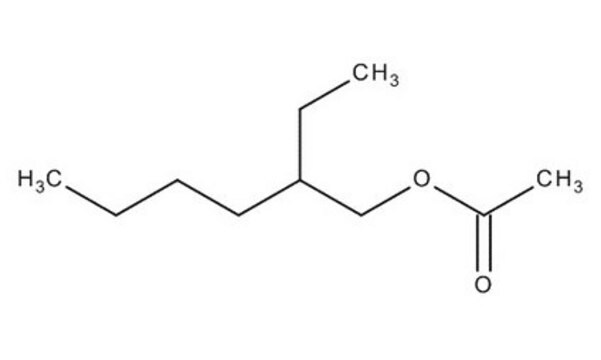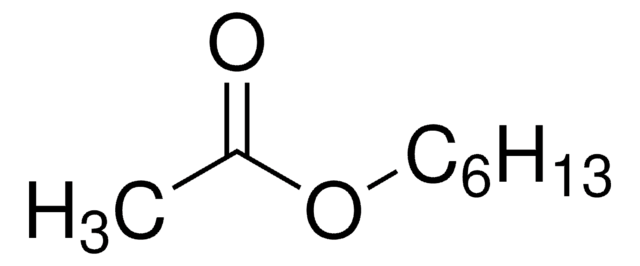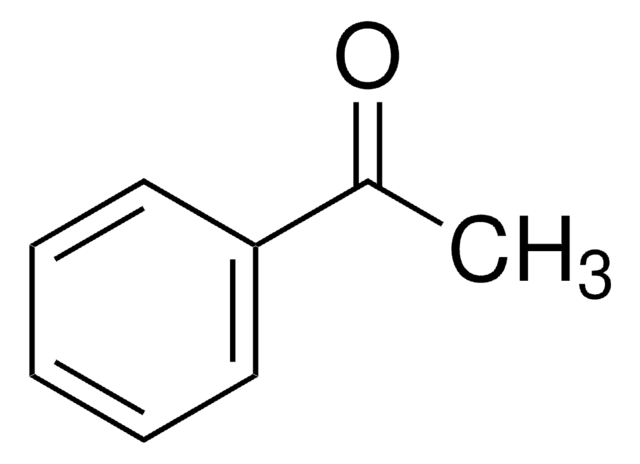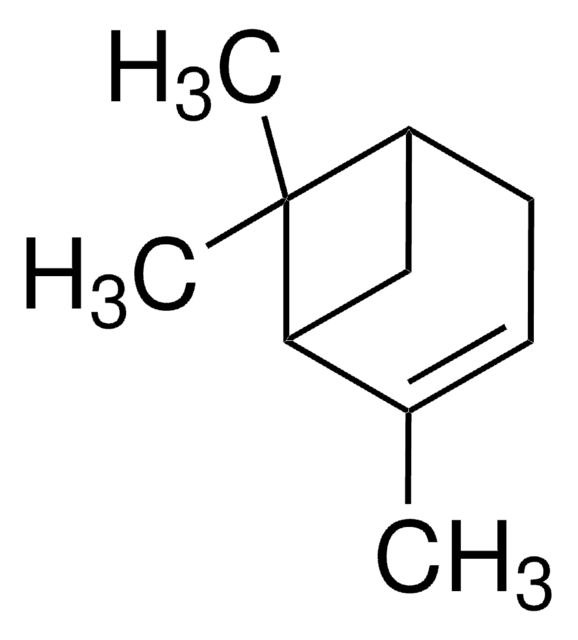All Photos(1)
About This Item
Linear Formula:
H3CCO2CH2CH(C2H5)(CH2)3CH3
CAS Number:
Molecular Weight:
172.26
EC Number:
MDL number:
UNSPSC Code:
12164502
PubChem Substance ID:
Flavis number:
9.381
NACRES:
NA.21
Recommended Products
biological source
synthetic
Quality Level
grade
Halal
Kosher
Assay
≥99%
refractive index
n20/D 1.418 (lit.)
bp
199 °C (lit.)
mp
−92 °C (lit.)
density
0.87 g/mL at 25 °C (lit.)
application(s)
flavors and fragrances
Documentation
see Safety & Documentation for available documents
food allergen
no known allergens
Organoleptic
earthy
SMILES string
CCCCC(CC)COC(C)=O
InChI
1S/C10H20O2/c1-4-6-7-10(5-2)8-12-9(3)11/h10H,4-8H2,1-3H3
InChI key
WOYWLLHHWAMFCB-UHFFFAOYSA-N
Looking for similar products? Visit Product Comparison Guide
General description
2-Ethylhexyl acetate is a flavoring compound that is reported to occur in muskmelon.
Application
- Impact of Leavening Agents on Flavor Profiles and Microbial Communities in Steamed Bread: A Comparative Analysis of Traditional Chinese Sourdough and Commercial Yeast.: This study explores the role of 2-ethylhexyl acetate in influencing the flavor profiles and microbial communities of steamed bread, highlighting its importance in food science and culinary applications (Fu et al., 2023).
Disclaimer
For R&D or non-EU Food use. Not for retail sale.
Signal Word
Warning
Hazard Statements
Precautionary Statements
Hazard Classifications
Skin Irrit. 2
Storage Class Code
10 - Combustible liquids
WGK
WGK 1
Flash Point(F)
159.8 °F
Flash Point(C)
71 °C
Personal Protective Equipment
dust mask type N95 (US), Eyeshields, Gloves
Choose from one of the most recent versions:
Already Own This Product?
Find documentation for the products that you have recently purchased in the Document Library.
Customers Also Viewed
Comparison of the volatile compositions and flavour properties of cantaloupe, Galia and honeydew muskmelons.
Kourkoutas D, et al.
Food Chemistry, 97(1), 95-102 (2006)
S Omi et al.
Journal of microencapsulation, 8(4), 465-478 (1991-10-01)
A model study was conducted to establish 2 feasible production and application systems for the long-term, sustained release of pheromone into the atmosphere of targeted areas. The desired goal of effective release was set at least half a year. 2-Ethylhexyl
Shinobu Oda et al.
Journal of bioscience and bioengineering, 112(2), 151-153 (2011-05-04)
In a liquid-liquid interface bioreactor using a CaCO₃-coated ballooned microsphere, 2-ethylhexyl acetate was efficiently hydrolyzed to 2-ethyl-1-hexanol with Absidia coerulea NBRC 4423 compared with using talc-coated or non-coated ballooned microsphere. It was assumed that CaCO₃ brought about stabilization of lipase
Our team of scientists has experience in all areas of research including Life Science, Material Science, Chemical Synthesis, Chromatography, Analytical and many others.
Contact Technical Service









